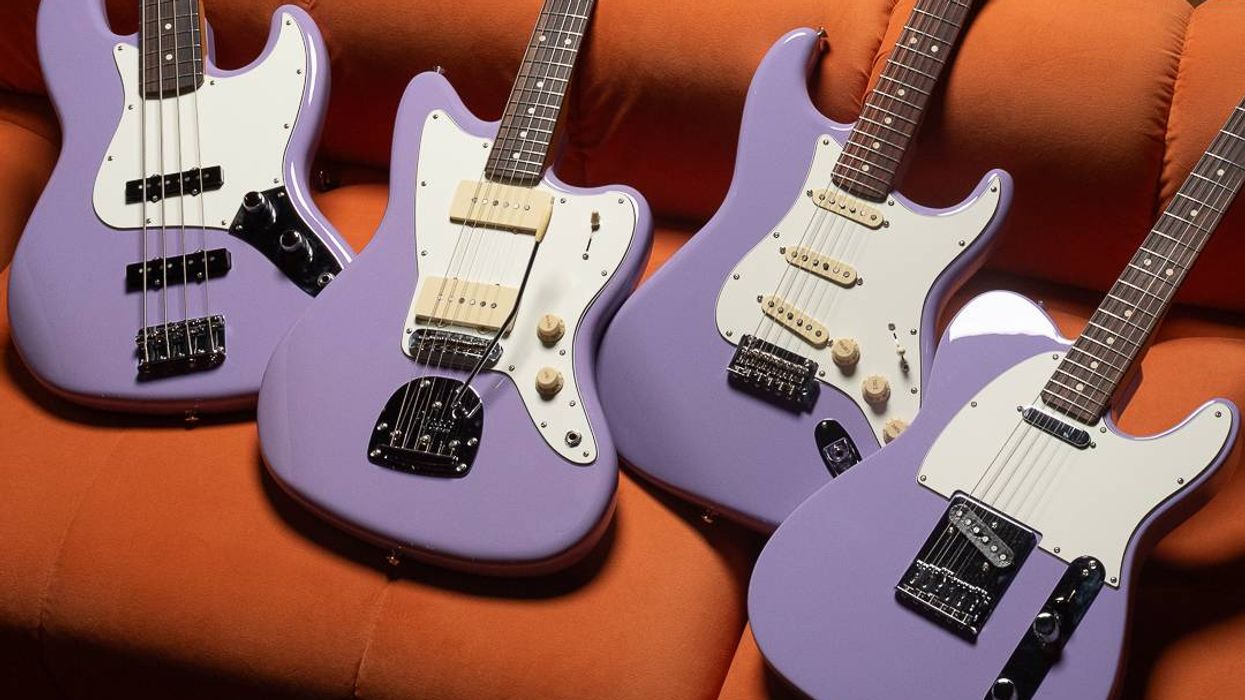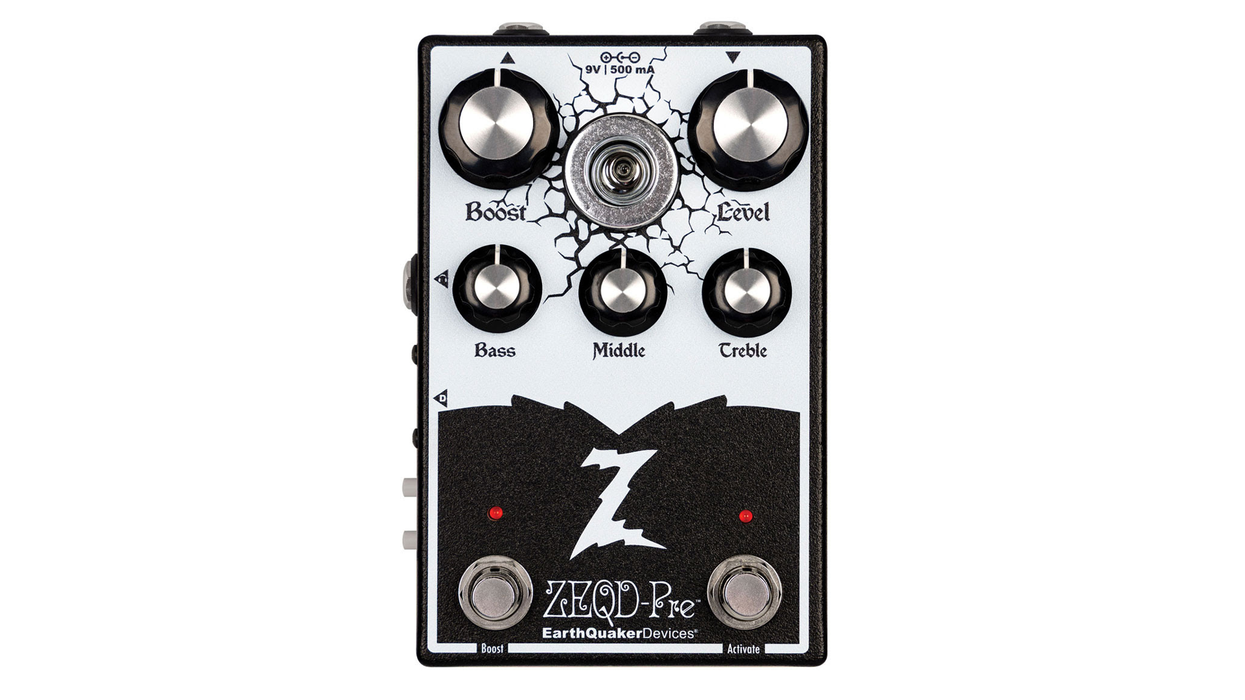Theory: Beginner
Lesson Overview:
• Learn one of the most essential chord shapes for funk music.
• Play a variety of rhythmic strumming patterns, from simple to complex.
• Gain an understanding of how the guitar locks in with the bass and drums in funk music. Click here to download a printable PDF of this lesson's notation.
Believe it or not, you can play a large number of classic funk songs using one chord shape. Of course, you’ll still have to develop a relentless strumming hand, but we’ll work on that too.
The D7 Shape
Oh, the humble D7 shape. From the primordial music of James Brown to the psychedelic sounds of Parliament Funkadelic and punk/funk of the Minutemen, the humble D7 shape is not to be underestimated. We’ll learn to appreciate the shape’s usefulness and versatility in this lesson, but first, a quick note on the naming of a shape versus its contextual chord name.
The visual layout of the guitar fretboard makes it very “shape friendly.” This is perhaps best illustrated by the popular CAGED system, which is based on a simple premise: Once you learn the 1st-position chord shapes of C, A, G, E, and D, you can then move those shapes up and down the fretboard to play any major or minor chord, arpeggio, or scale. Our lesson is based on the same principle, but all our attention will be focused on the 1st-position D7 shape.
Unfortunately, there is one possibility for confusion: In addition to moving this shape up and down the fretboard, we will also be moving it across the fretboard, and, from a theory and nomenclature standpoint, once we do that, the name of the chord will also change and sometimes it can have more than one name! In other words, when we play a D7 shape along the top three strings of the guitar, its root will change, but not its function—it will still be a rootless dominant 7 chord. But if we shift that same shape across the strings it could be a C#m, E6, or even F#9 depending on the context. Even though the focus of this lesson is on the D7 grip, you will also want to keep an eye on the proper, contextual chord names.
One-Shape Funk Evolution
Without question, James Brown invented funk. But Brown’s musical creation has its roots in the 1950s R&B and early-’60s soul music. So, before we investigate the syncopated strums of such funk classics as “Cold Sweat” and “Get Up (I Feel Like Being a) Sex Machine,” let’s try our hand at a foundational rhythm found in the precursors to funk.
Ex. 1 begins with the D7 shape in its everyday, 1st-position setting, but then quickly moves up and down the fretboard through a funky 12-bar blues similar to James Brown’s “Out of Sight.” (Many of Brown’s earliest songs are based around a 12-bar blues.) In this example, not only is the shape easy to finger and maneuver, but the strum is also rudimentary. But keep in mind, the simplicity of the guitar strum allows the bass and horns to get busy. Full disclosure: Although this D7 shape works perfectly in this context, it is not the shape used in “Out of Sight.” What actually gets played is a C7 shape, but that’s for another lesson.
Click here for Ex. 1
16th-note Strums
Before we get to the next song-based example, we’re obliged to work on your strumming hand. At the risk of oversimplifying, much of funk guitar comes down to 16th-notes, strummed up and down, with various accents and mutes/chokes thrown in to create an almost infinite variety of rhythmic syncopations. To work on this type of strumming, practice Ex. 2 as notated, then start experimenting with your own variations using different chord shapes and playing up and down the neck.
Click here for Ex. 2
Which brings us to Ex. 3, which employs both the D7 shape and a highly syncopated strum. Based on a common I–II–V progression, this groove is based on Funkadelic’s “Sexy Ways” and, like “Out of Sight,” has its roots in R&B music.
Click here for Ex. 3
Move It!
Now that we have a firm grasp of the D7 shape, let’s move it around and start getting busier and funkier. The following two examples are going to use the exact same shape that we used in Ex. 1, but we’ll move it over one string. As mentioned in the introduction, the shape will remain the same, but the name will change. In fact, even though we will use the same shape in the next two examples, we will give them different names in each example, because the bass line will dictate the overall harmony.
Ex. 4 is similar to another James Brown song, “Funky Drummer.” And while that tune is well-known for its drum break—which is sampled in literally thousands of hip-hop songs—Alfonzo Kellum’s rhythm guitar is also noteworthy. This phrase imitates Kellum’s part (there is a second, single-note guitar line in the original, not mimicked here) using only the D7 shape, but, thanks to the bass line, we can create the sound of a B9 chord moving to E9. It’s a laid-back funky groove.
Click here for Ex. 4
Punk Funk
To the uninitiated, it might seem a stretch to jump from James Brown to the seminal 1980s punk trio the Minutemen, but for those in the know, it’s not so surprising. The Minutemen had a wide range of influences, and funk played a big role in their music. Plus, one of their songs uses the D7 shape to great advantage. Ex. 5 pays homage to the Minutemen with a tight, five-chord, one-shape groove reminiscent of “Viet Nam.” Notice that the bass line creates a new harmonic context for our D7 shape. Also, pay close attention to the choked/muted strums in this example—they add to the piece’s overall momentum.
Click here for Ex. 5
Keep Movin’
Now let’s continue with our process of hopping over a string, which, coincidentally, makes our D7 shape, when its lowest note is played at the 5th fret, a D7 chord! Some players might notice that this shape, on these strings, is similar to both B7 and C7 shapes, minus a couple of notes, which is exactly the case. Nevertheless, in this context, we will continue to call this a D7 shape.
Ex. 6 is an exceedingly fun exercise, reminiscent of Ex. 2, which will test your 16th-note strumming skills. What we have here are three different strum patterns, each played four times in a row, and finally strung together to create a longer four-measure pattern. This groove is based on Prince’s “The Everlasting Now” and, in combination with Ex. 2 and diligence on your part, should improve your strumming significantly.
Click here for Ex. 6
Alternating between D7 and C#7, Ex. 7 slows things down and adds a hip chromatic move, comparable to Parliament’s “Dr. Funkenstein.” The interplay between the guitar and bass here is vital, with the bass playing the root and b7 over the D7 chord, followed by the b7 only over the C#7. For the audio example, I’ve added a second guitar with an envelope filter/auto-wah effect.
Click here for Ex. 7
Based on Jeff Beck’s “Constipated Duck,” Ex. 8 has the same chromatic move as Ex. 7, but with a slippery slide added for a bit of accent color. This example also changes keys. To accomplish this modulation, you merely move down two frets in measure five, then back up again at measure seven.
Click here for Ex. 8
Funky Beatles?
Okay, I know this last example is not the funkiest, however I couldn’t resist including it because this allows us to shift our D7 shape across the fretboard one last time. Also, I can’t think of any other songs that have this particular chord shape in it. (I vaguely recall playing it in at least one other tune; if any readers know of other recorded examples of this shape, in this fretboard position, please feel free to mention them in the comments.) Thus, the Beatles stand as pioneers for yet another reason, as Ex. 9 is based on “Sgt. Pepper’s Lonely Hearts Club Band.”
Click here for Ex. 9
Or Less?
The title of this lesson is “Funk Guitar in One Chord Shape or Less,” so what about the less? Easy. Just rest. Stop playing. Lay out. As James Brown declared, “Give the drummer some.”










![Rig Rundown: John 5 [2026]](https://www.premierguitar.com/media-library/youtube.jpg?id=62681883&width=1245&height=700&quality=70&coordinates=0%2C45%2C0%2C45)















